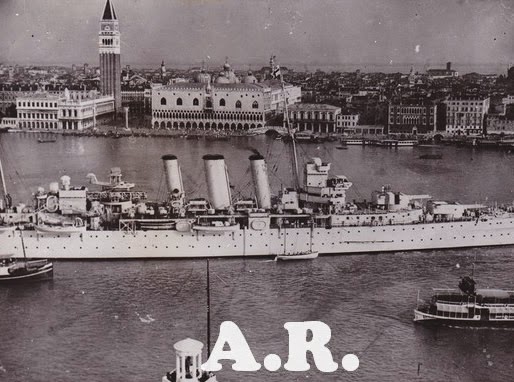Fotografía antigua Segunda Guerra Mundial El crucero HMS London en Venecia. Photo WWII agency, Cruiser H.M.S. London in Venice
Curiosa
fotografia aérea que representa una vista del crucero inglés H.M.S.
London en Venecia con el Campanile y la Plaza del Duomo como fondo.
La
vista de un buque de guerra, enorme en la foto en comparación con su
entorno,es una imagen impactante pues todos tenemos en la mente las
fotos, imágenes de Venecia hoy con sus góndolas llenas de turistas.
Wikipedia
London was laid down at Portsmouth Dockyard on 23 February 1926, launched on 14 September 1927 and commissioned on 31 January 1929.
- Fue un barco famoso en la historia marina pues intervino en la batalla para el hundimiento del Bismarck
London was involved in the pursuit of the German battleship Bismarck
in May 1941. During this time at sea many cracks appeared in her upper
deck and hull, due to the weight of the new superstructure causing
stresses. She entered a commercial shipyard on the River Tyne in October 1941 and was under repair until February 1942. London
then spent from October 1941 to November 1942 in the North Atlantic on
convoy protection duties in the company of several US Navy warships.
This time of operations in the heavy North Atlantic seas caused hull
cracks and popped rivets in her lower hull resulting in the ship again
going into the dry-dock in December 1942 for strengthening of the hull,
fitting of newer and more refined radar, and more light anti-aircraft
guns.
Agencias
Antes
de la Segunda Guerra Mundial, los fotógrafos que no trabajaban para
alguna revista importante, lo hacían para agencias. Existen tres tipos
de agencias:
Los fundadores podían producir temas de fondo o “grandes semanarios” que tuvieron mucho éxito.
El Picture Post consagró en 1938 a Robert Capa a los 25 años como el fotógrafo de guerra más importante del mundo.
Estas agencias viven en gran medida de la reventa de sus archivos.
- Agencias telegráficas. Difunden al mismo tiempo noticias escritas e imágenes. Abordan la actualidad día a día y sus fotógrafos son asalariados. La mayoría de las veces el suceso debe resumirse en una sola fotografía que muestra lo esencial. Los fotógrafos no son propietarios de sus imágenes y su publicación se firma con el nombre de la agencia. Algunas de estas agencias son: Associated Press (EEUU), United Press International (UPI), Reuter en Inglaterra, France-Presse (AFP), Tas (URSS)
- Agencias news y los semanarios. Funcionaban tanto con personal asalariado como con free-lance. Surgen en los años 30, y la más antigua en Francia es la Alliance Photo, creada y dirigida en 1934 por Maria Eisner, que luego dirigirá Magnum. Forman parte de este proyecto Capa, Chim, Denise Bellon, Pierre Boucher, Pierre Verger, René Zuber, Émeric Feher y Henri Cartier-Bresson. Luego se unirá Werner Bischof y Ernst Haas.
Los fundadores podían producir temas de fondo o “grandes semanarios” que tuvieron mucho éxito.
El Picture Post consagró en 1938 a Robert Capa a los 25 años como el fotógrafo de guerra más importante del mundo.
- Agencias de ilustración. Destinada a dar a conocer imágenes que tienen poca relación con la actualidad. Sus clientes suelen ser editores, instituciones, ministerios, museos, revistas especializadas en viajes y turismo, decoración…
Estas agencias viven en gran medida de la reventa de sus archivos.
.
The Second World War was documented on a huge scale by
thousands of photographers and artists who created millions of
pictures. American military photographers representing all of the
armed services covered the battlefronts around the world. Every
activity of the war was depicted--training, combat, support
services, and much more. On the home front, the many federal war
agencies produced and collected pictures, posters, and cartoons
on such subjects as war production, rationing, and civilian
relocation.
The pictures described in this list are from the holdings of the Still Picture Branch (NNSP) of the National Archives and Records Administration. Most are from the records of the Army Signal Corps in Record Group (RG) 111, the Department of the Navy in RG 80, the Coast Guard in RG 26, the Marine Corps in RG 127, and the Office of War Information in RG 208. Others were selected from the records of 12 additional agenci
http://www.archives.gov/
La exposición Magnum. 50 años de fotografía celebra los cincuenta años de producción fotográfica de la célebre agencia de fotografía, reconocida por su papel en la historia de la cultura visual de la segunda mitad del siglo XX y cuyo trabajo constituye la memoria gráfica del mundo moderno. Fundada en 1947, Magnum se empieza a definir en los años treinta a partir de la obra y los propósitos teórico-estéticos que defienden sus fundadores -Henri Cartier-Bresson, Robert Capa, George Rodger y David Seymour “Chim”-, especialmente a partir de los trabajos que realizan como reporteros en la Guerra Civil Española y en la Segunda Guerra Mundial. Con esas fotografías sientan las bases del moderno reportaje fotográfico, sustentado en dos principios: la necesidad de extrema proximidad al hecho que demandaba Robert Capa, y la teoría del “instante decisivo” (images à la sauvette), elaborada por Cartier-Bresson y publicada en 1952, la cual constituye para muchos el texto programático de esta manera de hacer fotoperiodismo
Los archivos fotográficos en España son ricos en cantidad y calidad .... Colección de la I Guerra Mundial: Agencia BUFA y Associated Illustration (4.000). 3. ...... En la segunda década del siglo mantuvo intensa relación con .
- L’ECPAD collecte, conserve, décrit et valorise les archives audiovisuelles et photographiques de la défense. Ces collections représentent aujourd’hui près de 6,7 millions de clichés et 52 000 titres de films et rushes de tournage. Ces documents sont portés à la connaissance du public et mis en consultation au sein de la Médiathèque du fort d’Ivry, en fonction de l’état d’avancement des inventaires, du traitement documentaire et de la numérisation
22 junio - 30 agosto, 1993
Edificio Sabatini, Planta 3
